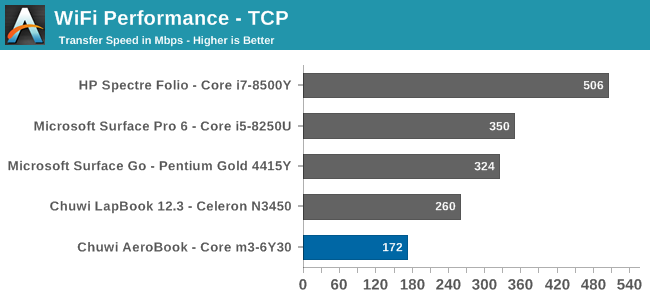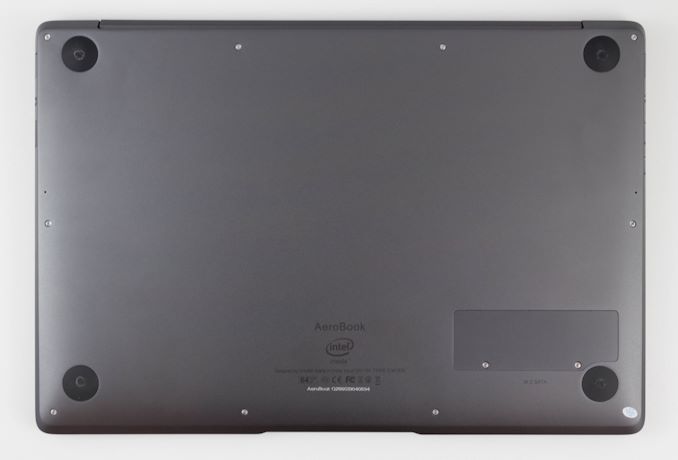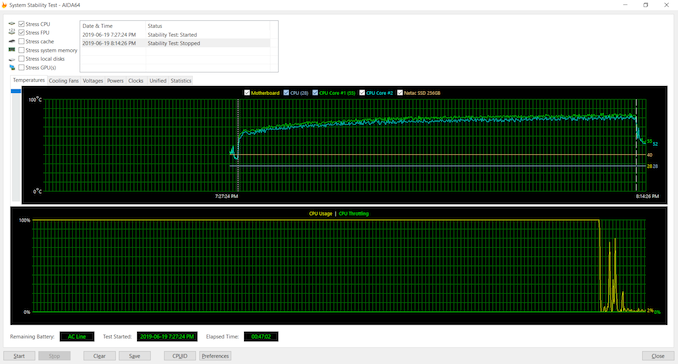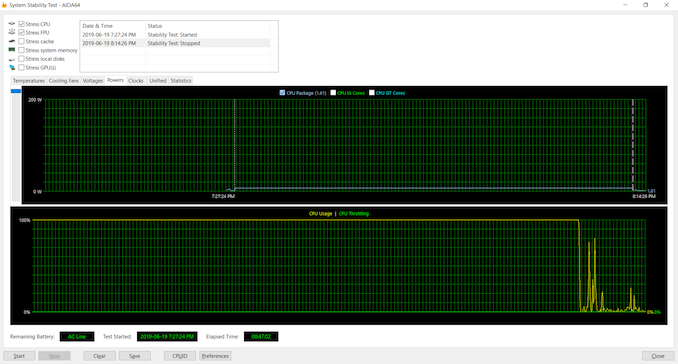The Chuwi AeroBook Review: One Small Step For Chuwi
by Brett Howse on June 21, 2019 8:00 AM ESTWireless
One area where Chuwi clearly focused on their price target was the wireless. We don’t often see a 1x1 solution anymore, but the AeroBook features just a single stream for Wi-Fi. Luckily that wireless card is an Intel Dual Band Wireless-AC 3165, and with Intel’s track record on network cards, at least some solace can be found in the connecting being rock solid.

As expected, the performance of just a single 5 GHz AC stream is much lower than what you’d get in any 2x2 wireless offering, which is the standard for most notebooks. But the connection was as solid as expected, with zero dropouts or reboots required to establish a Wi-Fi connection, which tends to be the case with Intel wireless adapters. The transfer rate is generally enough for most internet access, but if you want to copy files over the network, you’d likely be better off using USB.
Audio
The Chuwi AeroBook contains speakers. We could pretty much wrap it up there. Most notebooks don’t offer much in the way of dynamic range on their incredibly small speakers, but the AeroBook offers almost no bass at all. The speakers get reasonably loud, with around 80 dB(A) measured one inch over the trackpad, but there was little in the way of stereo separation and the speakers sound very poor. Luckily the 3.5 mm jack seemed to function well.
Thermals
One of the benefits of sticking with a low TDP processor is that Chuwi can continue to offer a completely fanless device. With only a 4.5-Watt TDP, the Core m3 is even a bit less TDP than a Gemini Lake Atom, which has a 6-Watt TDP, although the scenario design power is closer at 4.8 Watts.
To see how the AeroBook handles load, it was run at 100% CPU while monitoring the temperatures and power draw.
The AeroBook had no issues maintaining maximum performance. It quickly jumped to the 2.2 GHz maximum, drawing 7.56 Watts in the process, and then once its PL1 was exhausted it moved into a steady PL2 draw averaging about 6.8 Watts, and maintaining almost a 2.0 GHz frequency for the duration of the run.
The maximum CPU temperature was 85°C, but averaged closer to 75°C in steady state, and the notebook itself got warm on the bottom but never hot to the touch. Chuwi have had issues in the past with cooling, but it looks like they’ve got them sorted out on the AeroBook.
Software
Chuwi offers no additional software over the base install of Windows 10, which is something they’ve been consistent at, and a welcome change over many of the manufacturers who bundle in unwanted applications and bloat. That’s not to say that Windows 10 doesn’t offer bloat itself – because it does – but Chuwi at least isn’t adding on to that.
For some reason the company tends to put shortcuts on the desktop for This PC, Network, Control Panel, and your user profile, which gives the look a bit of an XP-era feel, and if a guess had to be made, it would be because XP was so popular in their native China. Luckily they can be deleted off the desktop if you like a clean desktop.













51 Comments
View All Comments
Mil0 - Sunday, June 23, 2019 - link
Ah, this article mentions that it wakes up when sleeping, but not when hibernated: https://www.zdnet.com/article/windows-10-tip-keep-...ArcadeEngineer - Friday, June 21, 2019 - link
I have had hibernated laptops wake up for windows updates before, it seems to be a quite new 'feature'.Rookierookie - Sunday, June 23, 2019 - link
They do a good job of waking you up in the middle of the night.zodiacfml - Saturday, June 22, 2019 - link
Windows update 1903 wakes my laptop from sleep. First time in the life of that 2015 laptopcfenton - Saturday, June 22, 2019 - link
"After a bit of howling and screaming they did offer me to send it to HongKong for a free replacement, and I am torn between using it just on external power or actually see if it gets back fixed."That right there should be a huge red flag for anyone considering Chuwi. If they're selling it in North America, then there should be somewhere I can send it for repair in North America. If they don't want to do that, then they should be cross-shipping (for free) at the very least.
Spunjji - Wednesday, June 26, 2019 - link
Even with weird / intense usage, it should take a *lot* longer than a year for a battery to swell like that. It was definitely a manufacturing fault.StormyParis - Friday, June 21, 2019 - link
Can you keep using it ? I've had huge durability issues with 3rd-tier Chinese OEMs (Teclast and Chuwi esp., Cube has been OK for me) and according to fellow complainers (a highly representative sample /s) on Techtablets' youtube channel, I'm not alone.They've managed to make stuff that's OK out of the box (it wasn't, a few years ago). Now it seems the things are still fragile, especially with iffy connectors and batteries.
I've had no issues whatsoever with 10+ XIaomi devices, and since they're barely more expensive than Teclast Chuwi et al., I'm sticking with Xiaomi for now.
DanNeely - Friday, June 21, 2019 - link
My Teclast T8 tablet's still in good shape after 15 months; but I went with a lower tier Chinese maker because I don't use my tablet much and didn't want to pay apple/samsung prices; but wanted something with a higher DPI display than Amazon's race to the bottom Kindles.I managed to keep my 8" Dell android tablet for about 4 years; despite the model I got being cursed with a highly fragile usb port so I'm not overly concerned about general breakableness.
OFelix - Friday, June 21, 2019 - link
There's a good chance I would buy this laptop apart from 1 thing:I do NOT buy laptops with glossy screens !!
eastcoast_pete - Friday, June 21, 2019 - link
Looks nice enough. The main no-go for me is the low battery life. Also, how long do Chuwi's keyboards and track pads last?